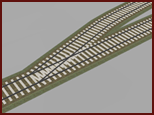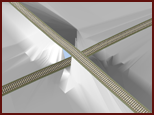Sketch railways in a model or proposal.
To add a railway
- Click




 .
.
- Click once on a railway style to select that style.
Note:
- If you want to use different railway styles than what are shown in the Select Draw Style catalog, you can create and edit railway styles using the Style Palette. See About editing styles for more information.
- Once you have sketched a railway, you can modify its style. See To apply styles to individual features for more information.
- You can combine a group of railway lines within 25 meters of each other to share a bridge or tunnel. The railway lines must share the same direction and cannot intersect. For more information, see To work with railway units by combining railway tracks.
- Sketch the path of the railway in the model or proposal.
Click the railway starting point and click again to place a point for each bend. Double-click to finish the railway.
InfraWorks 360 performs some automated processes when rail lines intersect roads or other rail lines. The following table outlines how rail lines act in certain situations.
Situation Result Visual Rail line(s) intersect a road.
A railway crossing is added at the intersection of the rail line(s) and the road.

Rail lines with the same track count intersect at an angle of less than 40°.
A switch is added where the two tracks intersect.

Rail lines with the same track count intersect at an angle greater than 40°.
The intersecting rail lines simply cross one another. No switch is added.

Rail lines with the same track count intersect, but have different stacking orders.
If the stacking order is larger, the new road forms a viaduct over the older road/rail line.
If the stacking order is lower, the new road forms a tunnel under the older road/rail line.
This also occurs if intersecting roads/rail lines differ in elevation by more than 2½ meters.

Rail lines with different track counts intersect.
The intersecting rail lines simply cross one another. No switch is added.

Railways are a Surface layer in the Model Explorer, and information about them appears on the Properties Palette. The number of railways, as well as information (such as the number of rail lines added and their total length) appears in the Railways section of the Proposals Manager.
To split a railway
- Select the railway.
- Right click on the railway to open the context menu and click Edit Mode.
- Right-click the point for the split and click Split Feature.